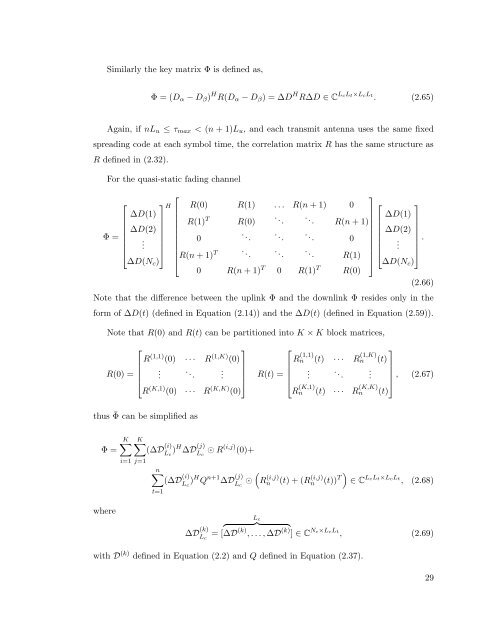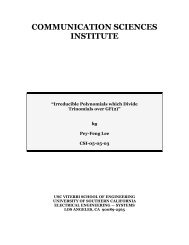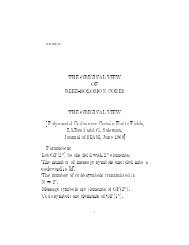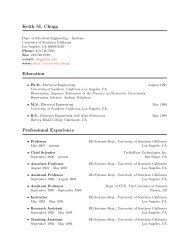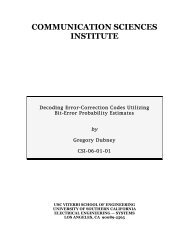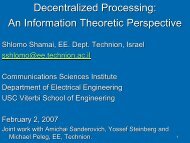Space-Time Block Codes for Wireless Systems - The ...
Space-Time Block Codes for Wireless Systems - The ...
Space-Time Block Codes for Wireless Systems - The ...
You also want an ePaper? Increase the reach of your titles
YUMPU automatically turns print PDFs into web optimized ePapers that Google loves.
Similarly the key matrix Φ is defined as,<br />
Φ = (D α − D β ) H R(D α − D β ) = ∆D H R∆D ∈ C LcLt×LcLt . (2.65)<br />
Again, if nL u ≤ τ max < (n + 1)L u , and each transmit antenna uses the same fixed<br />
spreading code at each symbol time, the correlation matrix R has the same structure as<br />
R defined in (2.32).<br />
For the quasi-static fading channel<br />
⎡ ⎤<br />
∆D(1)<br />
∆D(2)<br />
Φ =<br />
⎢ . ⎥<br />
⎣ ⎦<br />
∆D(N c )<br />
H<br />
⎡<br />
⎤<br />
R(0) R(1) . . . R(n + 1) 0 ⎡ ⎤<br />
R(1) T<br />
.<br />
R(0) .. . .. ∆D(1)<br />
R(n + 1)<br />
. 0 .. . .. . .. ∆D(2)<br />
0<br />
.<br />
⎢<br />
⎣<br />
R(n + 1) T . .. . .. . .. ⎢ . ⎥<br />
R(1) ⎥ ⎣ ⎦<br />
⎦ ∆D(N c )<br />
0 R(n + 1) T 0 R(1) T R(0)<br />
(2.66)<br />
Note that the difference between the uplink Φ and the downlink Φ resides only in the<br />
<strong>for</strong>m of ∆D(t) (defined in Equation (2.14)) and the ∆D(t) (defined in Equation (2.59)).<br />
Note that R(0) and R(t) can be partitioned into K × K block matrices,<br />
⎡<br />
⎤<br />
R (1,1) (0) · · · R (1,K) (0)<br />
R(0) =<br />
.<br />
⎢ . .. . ⎥<br />
⎣<br />
⎦<br />
R (K,1) (0) · · · R (K,K) (0)<br />
thus ¯Φ can be simplified as<br />
⎡<br />
R(t) = ⎢<br />
⎣<br />
⎤<br />
n (t) · · · R n<br />
(1,K) (t)<br />
.<br />
. .. . ⎥<br />
⎦ , (2.67)<br />
n (t) · · · R (K,K) (t)<br />
R (1,1)<br />
R (K,1)<br />
n<br />
Φ =<br />
where<br />
K∑<br />
K∑<br />
i=1 j=1<br />
(∆D (i)<br />
L c<br />
) H ∆D (j)<br />
L c<br />
⊙ R (i,j) (0)+<br />
n∑<br />
t=1<br />
(∆D (i)<br />
L c<br />
) H Q n+1 ∆D (j)<br />
L c<br />
∆D (k)<br />
(<br />
⊙<br />
R (i,j)<br />
n<br />
(t) + (R (i,j)<br />
n (t)) T ) ∈ C LcLt×LcLt , (2.68)<br />
L c<br />
{ }} {<br />
L c<br />
= [ ∆D (k) , . . . , ∆D (k) ] ∈ C Nc×LcLt , (2.69)<br />
with D (k) defined in Equation (2.2) and Q defined in Equation (2.37).<br />
29


